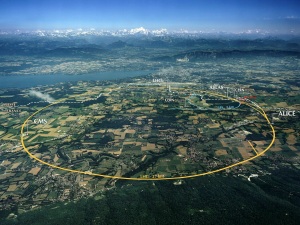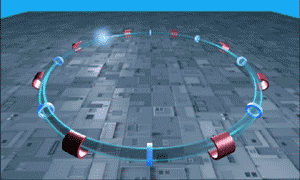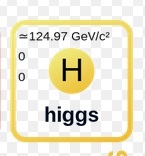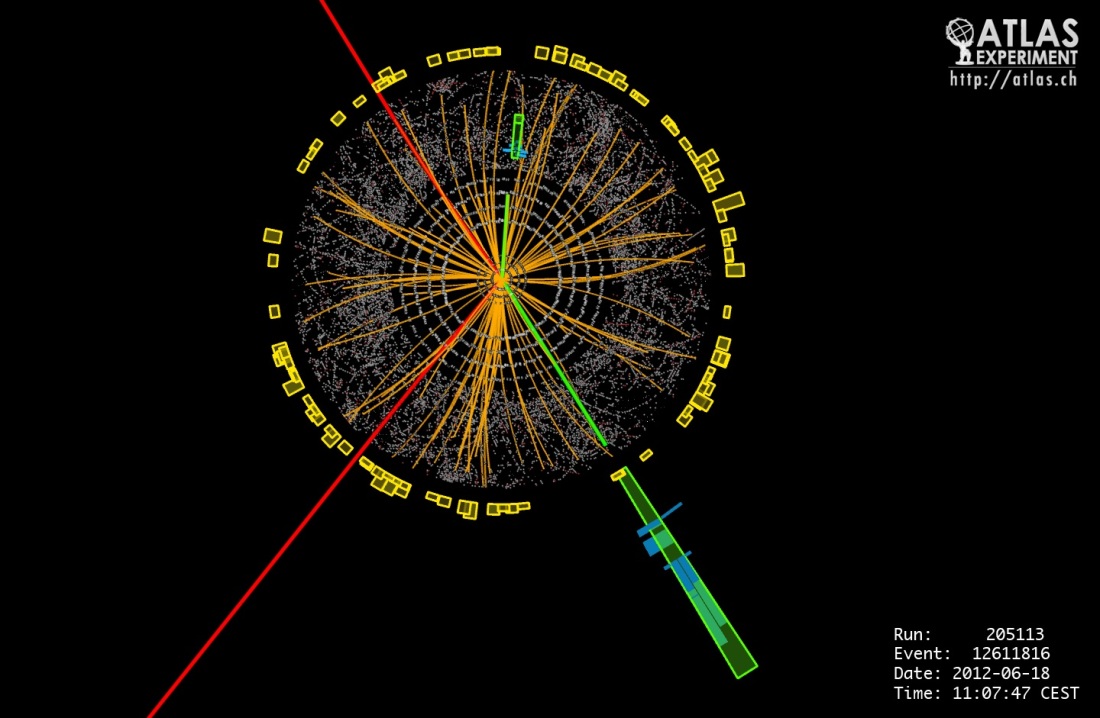From The University of Rochester
And

 The European Organization for Nuclear Research [La Organización Europea para la Investigación Nuclear][Organization européenne pour la recherche nucléaire] [Europäische Organization für Kernforschung](CH)[CERN] Compact Muon Solenoid Detector.
The European Organization for Nuclear Research [La Organización Europea para la Investigación Nuclear][Organization européenne pour la recherche nucléaire] [Europäische Organization für Kernforschung](CH)[CERN] Compact Muon Solenoid Detector.
6.11.24
David Andreatta

EXPERIMENTING WITH ENTANGLEMENT: The inside of the Compact Muon Solenoid (CMS) experiment at the Large Hadron Collider. Rochester physicists working at the detector have observed spin entanglement between top quarks and top antiquarks persisting at long distances and high speeds. (CERN photo / Maximilien Brice)
__________________________________________
The researchers have confirmed that quantum entanglement persists between top quarks, the heaviest known fundamental particles.
An experiment by a group of physicists led by University of Rochester physics professor Regina Demina has produced a significant result related to quantum entanglement—an effect that Albert Einstein called “spooky action at a distance.”
Entanglement concerns the coordinated behavior of miniscule particles that have interacted but then moved apart. Measuring properties—like position or momentum or spin—of one of the separated pair of particles instantaneously changes the results of the other particle, no matter how far the second particle has drifted from its twin. In effect, the state of one entangled particle, or qubit, is inseparable from the other.
Quantum entanglement has been observed between stable particles, such as photons or electrons.
But Demina and her group broke new ground in that they found, for the first time, entanglement to persist between unstable top quarks and their antimatter partners at distances farther than what can be covered by information transferred at the speed of light. Specifically, the researchers observed spin correlation between the particles.
Hence, the particles demonstrated what Einstein described as “spooky action at a distance.”
A ‘new avenue’ for quantum exploration
The finding was reported by the Compact Muon Solenoid (CMS) Collaboration at the European Center for Nuclear Research, or CERN, where the experiment was conducted.
“Confirming the quantum entanglement between the heaviest fundamental particles, the top quarks, has opened up a new avenue to explore the quantum nature of our world at energies far beyond what is accessible,” the report read.
CERN, located near Geneva, Switzerland, is the world’s largest particle physics laboratory.


Production of top quarks requires very high energies accessible at the Large Hadron Collider (LHC), which enables scientists to send high-energy particles spinning around a 17-mile underground track at close to the speed of light.
The phenomenon of entanglement has become the foundation of a burgeoning field of quantum information science that has broad implications in areas like cryptography and quantum computing.
Top quarks, each as heavy as an atom of gold, can only be produced at colliders, such as LHC, and thus are unlikely to be used to build a quantum computer. But studies like those conducted by Demina and her group can shed light on how long entanglement persists, whether it is passed on to the particles’ “daughters” or decay products, and what, if anything, ultimately breaks the entanglement.
Theorists believe that the universe was in an entangled state after its initial fast expansion stage. The new result observed by Demina and her researchers could help scientists understand what led to the loss of the quantum connection in our world.
Top quarks in quantum long-distance relationships
Demina recorded a video for CMS social media channels to explain her group’s result. She used the analogy of an indecisive king of a distant land, whom she called “King Top.”
King Top gets word that his country is being invaded, so he sends messengers to tell all the people of his land to prepare to defend. But then, Demina explains in the video, he changes his mind and sends messengers to order the people to stand down.
“He keeps flip flopping like this, and nobody knows what his decision will be at the next moment,” Demina says.
Nobody, Demina goes on to explain, except the leader of one village in this kingdom who is known as “Anti-Top.”
“They know each other’s state of mind at any moment in time,” Demina says.
Demina’s research group consists of herself and graduate student Alan Herrera and postdoctoral fellow Otto Hindrichs.
As a graduate student, Demina was on the team that discovered the top quark in 1995. Later, as a faculty member at Rochester, Demina co-led a team of scientists from across the US that built a tracking device that played a key role in the 2012 discovery of the Higgs boson—an elementary particle that helps explains the origin of mass in the universe.
______________________________
Higgs




______________________________
Rochester researchers have a long history at CERN as part of the CMS Collaboration, which brings together physicists from around the globe.

Recently, another Rochester team achieved a significant milestone in measuring the electroweak mixing angle, a crucial component of the Standard Model of Particle Physics, which explains how the building blocks of matter interact.

See the full article here .
Comments are invited and will be appreciated, especially if the reader finds any errors which I can correct.
five-ways-keep-your-child-safe-school-shootings
Please help promote STEM in your local schools.

The University of Rochester is a private research university in Rochester, New York. The university grants undergraduate and graduate degrees, including doctoral and professional degrees.
The University of Rochester enrolls approximately 6,800 undergraduates and 5,000 graduate students. Its 158 buildings house over 200 academic majors. The University of Rochester is the 7th largest employer in the Finger lakes region of New York.
The College of Arts, Sciences, and Engineering is home to departments and divisions of note. The Institute of Optics was founded in 1929 through a grant from Eastman Kodak and Bausch and Lomb as the first educational program in the US devoted exclusively to Optics and awards approximately half of all Optics degrees nationwide and is widely regarded as the premier Optics program in the nation and among the best in the world.
The Departments of Political Science and Economics have made a significant and consistent impact on positivist social science since the 1960s and historically rank in the top 5 in their fields. The Department of Chemistry is noted for its contributions to synthetic Organic Chemistry, including the first lab-based synthesis of morphine. The Rossell Hope Robbins Library serves as The University of Rochester’s resource for Old and Middle English texts and expertise. The university is also home to Rochester’s Laboratory for Laser Energetics, a Department of Energy supported national laboratory.


The University of Rochester’s Eastman School of Music ranks high among undergraduate music schools in the U.S. The Sibley Music Library at Eastman is the largest academic music library in North America and holds the third largest collection in the United States.
In its history The University of Rochester alumni and faculty have earned Nobel Prizes; Pulitzer Prizes; Grammy Awards; Guggenheim Awards; there are members of National Academy of Sciences; National Academy of Engineering; National Academy of Inventors; and National Academy of Inventors Hall of Fame; and Rhodes Scholarships.
Early history
The University of Rochester traces its origins to The First Baptist Church of Hamilton (New York) which was founded in 1796. The church established the Baptist Education Society of the State of New York later renamed the Hamilton Literary and Theological Institution in 1817. This institution gave birth to both Colgate University and the University of Rochester. Its function was to train clergy in the Baptist tradition. When it aspired to grant higher degrees, it created a collegiate division separate from the theological division.
The collegiate division was granted a charter by the State of New York in 1846 after which its name was changed to Madison University. John Wilder and the Baptist Education Society urged that the new university be moved to Rochester, New York. However, legal action prevented the move. In response, dissenting faculty, students, and trustees defected and departed for Rochester, where they sought a new charter for a new university.
Madison University was eventually renamed as Colgate University.
Founding
Asahel C. Kendrick- professor of Greek- was among the faculty that departed Madison University for The University of Rochester. Kendrick served as acting president while a national search was conducted. He reprised this role until 1853 when Martin Brewer Anderson of the Newton Theological Seminary in Massachusetts was selected to fill the inaugural posting.
The University of Rochester’s new charter was awarded by the Regents of the State of New York on January 31, 1850. The charter stipulated that The University of Rochester have $100,000 in endowment within five years upon which the charter would be reaffirmed. An initial gift of $10,000 was pledged by John Wilder which helped catalyze significant gifts from individuals and institutions.
Classes began that November with approximately 60 students enrolled including 28 transfers from Madison. From 1850 to 1862 the university was housed in the old United States Hotel in downtown Rochester on Buffalo Street near Elizabeth Street- today West Main Street near the I-490 overpass. On a February 1851 visit Ralph Waldo Emerson said of the university:
“They had bought a hotel, once a railroad terminus depot, for $8,500, turned the dining room into a chapel by putting up a pulpit on one side, made the barroom into a Pythologian Society’s Hall, & the chambers into Recitation rooms, Libraries, & professors’ apartments, all for $700 a year. They had brought an omnibus load of professors down from Madison bag and baggage… called in a painter and sent him up the ladder to paint the title “University of Rochester” on the wall, and they had runners on the road to catch students. And they are confident of graduating a class of ten by the time green peas are ripe.”
For the next 10 years The University of Rochester expanded its scope and secured its future through an expanding endowment; student body; and faculty. In parallel a gift of 8 acres of farmland from local businessman and Congressman Azariah Boody secured the first campus of The University of Rochester upon which Anderson Hall was constructed and dedicated in 1862. Over the next sixty years this Prince Street Campus grew by a further 17 acres and was developed to include fraternity houses; dormitories; and academic buildings including Anderson Hall; Sibley Library; Eastman and Carnegie Laboratories the Memorial Art Gallery and Cutler Union.
Twentieth century
Coeducation
The first female students were admitted in 1900- the result of an effort led by Susan B. Anthony and Helen Barrett Montgomery. During the 1890s a number of women took classes and labs at The University of Rochester as “visitors” but were not officially enrolled nor were their records included in the college register. President David Jayne Hill allowed the first woman- Helen E. Wilkinson- to enroll as a normal student although she was not allowed to matriculate or to pursue a degree. Thirty-three women enrolled among the first class in 1900 and Ella S. Wilcoxen was the first to receive a degree in 1901. The first female member of the faculty was Elizabeth Denio who retired as Professor Emeritus in 1917. Male students moved to River Campus upon its completion in 1930 while the female students remained on the Prince Street campus until 1955.
Expansion
Major growth occurred under the leadership of Benjamin Rush Rhees over his 1900-1935 tenure. During this period George Eastman became a major donor giving more than $50 million to the university during his life. Under the patronage of Eastman, the Eastman School of Music was created in 1921. In 1925 at the behest of the General Education Board and with significant support for John D. Rockefeller George Eastman and Henry A. Strong’s family medical and dental schools were created. The university award its first Ph.D that same year.
During World War II The University of Rochester was one of 131 colleges and universities nationally that took part in the V-12 Navy College Training Program which offered students a path to a Navy commission. In 1942, The University of Rochester was invited to join the Association of American Universities as an affiliate member and it was made a full member by 1944. Between 1946 and 1947 in infamous uranium experiments researchers at the university injected uranium-234 and uranium-235 into six people to study how much uranium their kidneys could tolerate before becoming damaged.
In 1955 the separate colleges for men and women were merged into The College on the River Campus. In 1958 three new schools were created in engineering, business administration and education. The Graduate School of Management was named after William E. Simon- former Secretary of the Treasury in 1986. He committed significant funds to the school because of his belief in the school’s free market philosophy and grounding in economic analysis.
Financial decline and name change controversy
Following the princely gifts given throughout his life George Eastman left the entirety of his estate to The University of Rochester after his death by suicide. The total of these gifts surpassed $100 million before inflation and as such The University of Rochester enjoyed a privileged position amongst the most well endowed universities. The University of Rochester’s financial position has ranked third, near Harvard University’s endowment and the University of Texas System’s Permanent University Fund . Due to a decline in the value of large investments and a lack of portfolio diversity The University of Rochester ‘s place dropped to the top 25 by the end of the 1980s. At the same time the preeminence of the city of Rochester’s major employers began to decline.
In response The University of Rochester commissioned a study to determine if the name of the institution should be changed to “Eastman University” or “Eastman Rochester University”. The study concluded a name change could be beneficial because the use of a place name in the title led respondents to incorrectly believe it was a public university, and because the name “Rochester” connoted a “cold and distant outpost.” Reports of the latter conclusion led to controversy and criticism in the Rochester community. Ultimately, the name “The University of Rochester” was retained.
Renaissance Plan
In 1995 The University of Rochester president Thomas H. Jackson announced the launch of a “Renaissance Plan” for The University of Rochester that reduced enrollment from 4,500 to 3,600 creating a more selective admissions process. The plan also revised the undergraduate curriculum significantly creating the current system with only one required course and only a few distribution requirements known as clusters. Part of this plan called for the end of graduate doctoral studies in Chemical Engineering; comparative literature; linguistics; and Mathematics, the last of which was met by national outcry. The plan was largely scrapped and Mathematics exists as a graduate course of study to this day.
Twenty-first century
Meliora Challenge
Shortly after taking office university president Joel Seligman commenced the private phase of the “Meliora Challenge”- a $1.2 billion capital campaign- in 2005. The campaign reached its goal in 2015- a year before the campaign was slated to conclude. In 2016, The University of Rochester announced the Meliora Challenge had exceeded its goal and surpassed $1.36 billion. These funds were allocated to support over 100 new endowed faculty positions and nearly 400 new scholarships.
The Mangelsdorf Years
On December 17, 2018 The University of Rochester announced that Sarah C. Mangelsdorf would succeed Richard Feldman as President of the University. Her term started in July 2019 with a formal inauguration following in October during Meliora Weekend. Mangelsdorf is the first woman to serve as President of the University and the first person with a degree in psychology to be appointed to Rochester’s highest office.
In 2019 students from China mobilized by the Chinese Students and Scholars Association (CSSA) defaced murals in the University’s access tunnels which had expressed support for the 2019 Hong Kong Protests, condemned the oppression of the Uighurs, and advocated for Taiwanese independence. The act was widely seen as a continuation of overseas censorship of Chinese issues. In response a large group of students recreated the original murals. There have also been calls for Chinese government run CSSA to be banned from campus.
Research
The University of Rochester is a member of the Association of American Universities and is classified among “R1: Doctoral Universities – Very High Research Activity”.
Rochester has ranked very highly nationally in research spending.
Some of the major research centers include the Laboratory for Laser Energetics, a laser-based nuclear fusion facility, and the extensive research facilities at the University of Rochester Medical Center.
Recently The University of Rochester has also engaged in a series of new initiatives to expand its programs in Biomedical Engineering and Optics including the construction of the new $37 million Robert B. Goergen Hall for Biomedical Engineering and Optics on the River Campus.
Other new research initiatives include a cancer stem cell program and a Clinical and Translational Sciences Institute. The University of Rochester also has the ninth highest technology revenue among U.S. higher education institutions. Notable patents include Zoloft and Gardasil. WeBWorK, a web-based system for checking homework and providing immediate feedback for students was developed by The University of Rochester professors Gage and Pizer. The system is now in use at over 800 universities and colleges as well as several secondary and primary schools. The University of Rochester scientists work in diverse areas. For example, physicists developed a technique for etching metal surfaces such as platinum; titanium; and brass with powerful lasers enabling self-cleaning surfaces that repel water droplets and will not rust if tilted at a 4 degree angle; and medical researchers are exploring how brains rid themselves of toxic waste during sleep.

